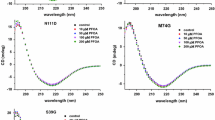Abstract
Intestinal fatty acid binding protein (I-FABP) is present at high levels in the absorptive cells of the intestine (enterocytes) where it plays a role in the intracellular solubilization of fatty acids (FA). However, I-FABP has also been shown to bind to a range of non-FA ligands, including some lipophilic drug molecules, albeit with generally lower affinity than FA. The significance of these lower affinity interactions with exogenous compounds is not known. In this manuscript, we describe further characterization of drug-rat I-FABP binding interactions using a thermal-shift assay. A structural explanation of the observed affinity of rat I-FABP for different drugs based on spectroscopic data and modeling experiments is presented. In addition, immunocytochemistry has been used to probe the expression of I-FABP in a cell culture model reflective of the absorptive cells of the small intestine. Taken together, these data suggest a possible role for I-FABP in the disposition of some lipophilic drugs within the enterocyte.





Similar content being viewed by others
References
Avdeef A (2003) Drug bioavailability: estimation of solubility, permeability, absorption and bioavailability. Wiley-VCH, Weinheim, Germany
Avdeef A (2003) Absorption and drug development solubility, permeability, and charge state. Wiley-Interscience, Hoboken, NJ
Lennernas H (1998) Human intestinal permeability. J Pharm Sci 87:403–410. doi:10.1021/js970332a
Banaszak L, Winter N, Xu Z, Bernlohr DA, Cowan S, Jones TA (1994) Lipid-binding proteins: a family of fatty acid and retinoid transport proteins. Adv Protein Chem 45:89–151. doi:10.1016/S0065-3233(08)60639-7
Coe NR, Bernlohr DA (1998) Physiological properties and functions of intracellular fatty acid-binding proteins. Biochim Biophys Acta 1391:287–306
Lücke C, Gutiérrez-González LH, Hamilton J (2003) Intracellular lipid binding proteins: evolution, structure and ligand binding. In: Duttaroy AK, Spener F (eds) Cellular proteins and their fatty acids in health and disease. Wiley-VCH, Weinheim, Germany
Paulussen RJ, Van Moerkerk HT, Veerkamp JH (1990) Immunochemical quantitation of fatty acid-binding proteins. Tissue distribution of liver and heart FABP types in human and porcine tissues. Int J Biochem 22:393–398. doi:10.1016/0020-711X(90)90142-P
Bass NM, Manning JA (1986) Tissue expression of three structurally different fatty acid binding proteins from rat heart muscle, liver, and intestine. Biochem Biophys Res Commun 137:929–935. doi:10.1016/0006-291X(86)90314-1
Hodsdon ME, Cistola DP (1997) Discrete backbone disorder in the nuclear magnetic resonance structure of apo intestinal fatty acid-binding protein: implications for the mechanism of ligand entry. Biochem 36:1450–1460. doi:10.1021/bi961890r
Wolfrum C, Borrmann CM, Börchers T, Spener F (2001) Fatty acids and hypolipidemic drugs regulate peroxisome proliferator-activated receptors alpha- and gamma-mediated gene expression via liver fatty acid binding protein: a signaling path to the nucleus. Proc Natl Acad Sci USA 98:2323–2328. doi:10.1073/pnas.051619898
Velkov T, Chuang S, Wielens J, Sakellaris H, Charman WN, Porter CJ, Scanlon MJ (2005) The interaction of lipophilic drugs with intestinal fatty acid-binding protein. J Biol Chem 280:17769–17776. doi:10.1074/jbc.M410193200
Velkov T, Horne J, Laguerre A, Jones E, Scanlon MJ, Porter CJ (2007) Examination of the role of intestinal fatty acid-binding protein in drug absorption using a parallel artificial membrane permeability assay. Chem Biol 14:453–465. doi:10.1016/j.chembiol.2007.03.009
Wolfrum C, Börchers T, Sacchettini JC, Spener F (2000) Binding of fatty acids and peroxisome proliferators to orthologous fatty acid binding proteins from human, murine, and bovine liver. Biochem 39:1469–1474. doi:10.1021/bi991638u
Marley J, Lu M, Bracken C (2001) A method for efficient isotopic labeling of recombinant proteins. J Biomol NMR 20:71–75. doi:10.1023/A:1011254402785
Pantoliano MW, Petrella EC, Kwasnoski JD, Lobanov VS, Myslik J, Graf E, Carver T, Asel E, Springer BA, Lane P, Salemme FR (2001) High-density miniaturized thermal shift assays as a general strategy for drug discovery. J Biomol Screen 6:429–440. doi:10.1177/108705710100600609
Lo M, Aulabaugh A, Jin G, Cowling R, Bard J, Malamas M, Ellestad G (2004) Evaluation of fluorescence-based thermal shift assays for hit identification in drug discovery. Anal Biochem 332:153–159. doi:10.1016/j.ab.2004.04.031
Delaglio F, Grzesiek S, Vuister GW, Zhu G, Pfeifer J, Bax A (1995) NMRPipe: a multidimensional spectral processing system based on UNIX pipes. J Biomol NMR 6:277–293. doi:10.1007/BF00197809
Goddard TD, Kneller DG (2006) SPARKY 3. http://www.cgl.ucsf.edu/home/sparky
Friesner RA, Banks JL, Murphy RB, Halgren TA, Klicic JJ, Mainz DT, Repasky MP, Knoll EH, Shelley M, Perry JK, Shaw DE, Francis P, Shenkin PS (2004) Glide: a new approach for rapid, accurate docking and scoring. J Med Chem 47:1739–1749. doi:10.1021/jm0306430
DeLano WL (2002) PyMol. http://www.pymol.org
Sacchettini JC, Gordon JI, Banaszak LJ (1989) Crystal structure of rat intestinal fatty-acid-binding protein. Refinement and analysis of the Escherichia coli-derived protein with bound palmitate. J Mol Biol 208:327–339. doi:10.1016/0022-2836(89)90392-6
Sacchettini JC, Gordon JI (1993) Rat intestinal fatty acid binding protein. A model system for analyzing the forces that can bind fatty acids to proteins. J Biol Chem 268:18399–18402
Ockner RK, Manning JA, Poppenhausen RB, Ho WK (1972) A binding protein for fatty acids in cytosol of intestinal mucosa, liver, myocardium, and other tissues. Science 177:56–58. doi:10.1126/science.177.4043.56
Storch J, Herr FM, Hsu KT, Kim HK, Liou HL, Smith ER (1996) The role of membranes and intracellular binding proteins in cytosolic transport of hydrophobic molecules: fatty-acid binding proteins. Comp Biochem Physiol 115B:333–339
Shen DD, Kunze KL, Thummel KE (1997) Enzyme-catalyzed processes of first-pass hepatic and intestinal drug extraction. Adv Drug Deliv Rev 27:99–127. doi:10.1016/S0169-409X(97)00039-2
Doherty MM, Charman WN (2002) The mucosa of the small intestine: how clinically relevant as an organ of drug metabolism? Clin Pharmacokinet 4:235–253. doi:10.2165/00003088-200241040-00001
Dube N, Delvin E, Yotov W, Garofalo C, Bendayan M, Veerkamp JH, Levy E (2001) Modulation of intestinal and liver fatty acid-binding Proteins in caco-2 cells by lipids, hormones and cytokines. J Cell Biochem 81:613–620. doi:10.1002/jcb.1090
Acknowledgments
T. Velkov is the recipient of a Peter Doherty Fellowship (384300) from the National Health and Medical Research Council, Australia. This work was supported by grants from the Australian Research Council (DP0342458, DP0664069).
Author information
Authors and Affiliations
Corresponding author
Rights and permissions
About this article
Cite this article
Velkov, T., Lim, M.L.R., Horne, J. et al. Characterization of lipophilic drug binding to rat intestinal fatty acid binding protein. Mol Cell Biochem 326, 87–95 (2009). https://doi.org/10.1007/s11010-008-0009-x
Received:
Accepted:
Published:
Issue Date:
DOI: https://doi.org/10.1007/s11010-008-0009-x




